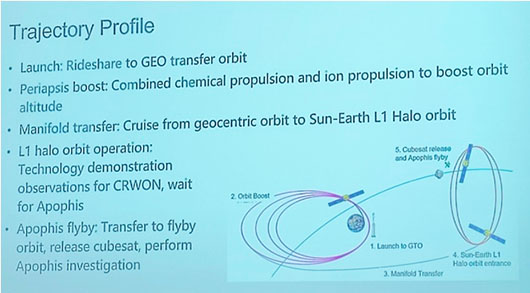Special to CosmicTribune.com, September 10, 2025
By Richard Fisher
There is now a race involving government funded programs and universities to reach the asteroid Apophis, a 375-meter diameter asteroid only discovered in 2004 but that will reach a nearest distance of 32,000 kilometers (20,000 miles) from Earth on April 13, 2029.
But it is also possible that China is developing a mission to this asteroid to advance its capabilities for “Planetary Defense.”

Projects to investigate Apophis, or to conduct a close flyby, are underway from the U.S. National Aeronautics and Space Administration (NASA), the European Space Agency (ESA) in cooperation with the Japan Aerospace Exploration Agency (JAXA), plus a coalition of universities in China.
The Chinese coalition, according to briefing slides revealed on the X page of eminent Chinese space journalist Andrew Jones, is led by the Key State Laboratory of Lunar and Planetary Sciences (SKL Planets) at the Macau University of Science and Technology, with Sun Yat Sen University, Harbin Institute of Technology, Beijing Institute of Technology, Beihang University, and the Shanghai Astronomical Observatory.
These slides indicate that the Chinese mission would just be a “flyby” to measure the “fundamental properties,” and “investigate the effects of planet close encounters” with the asteroid, such as its “rotational status…before and after Earth encounter.”
The mission would involve launching a small satellite into Geostationary Transfer Orbit (GTO) and then using chemical and ion (electric) propulsion to reach a point in the Earth-Sun L-1 Lagrangian Point (an area of equal gravitational pull) to station the satellite for its flyby mission.
This mission would use a 44-kilogram main satellite equipped with a small doppler radar, a camera and a small laser marker, that during the flyby would also release a much smaller micro cubsat satellite, also equipped with a small radar, camera and laser marker, to conduct the investigation.
Now the briefing slides do not mention the conduct of any kind of “impact” of Apophis, which is interesting given the Sept. 4 announcement by Wu Weiren, chief designer of China’s lunar exploration program and also newly elected president of the International Deep Space Exploration Association (IDSEA), during his keynote report to the third International Deep Space Exploration Conference held in Hefei, China.
Wu Weiren, who is also China’s chief unofficial space “ambassador,” noted that “China has recently unveiled its plan to initiate an experimental verification project to demonstrate and test the effectiveness of its asteroid defense system,” according to a Sept. 8 article in state media Global Times.
Global Times further noted that “Wu outlined China’s asteroid exploration and defense system in detail…Wu revealed that in the near future, China will conduct a kinetic impact demonstration and verification mission on an asteroid posing a potential threat to Earth.”
Full Text . . . . Current Edition . . . . Subscription Information

You must be logged in to post a comment Login